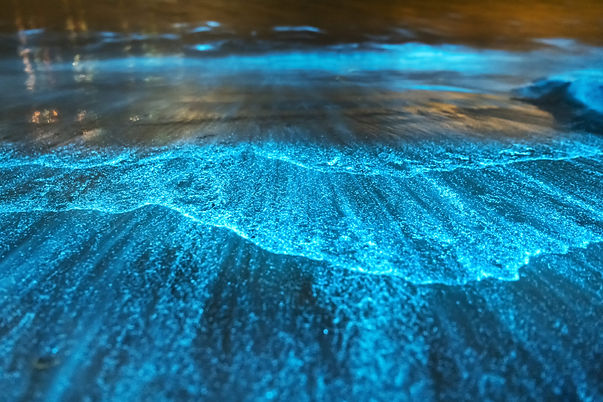
Fish Fertilize Trees
By Maya C. Lemaire


2018

2018

Bioluminescence: The science of why living things glow
Have you ever walked along a beach and noticed the waves start glowing?
Well I did, and it sparked my curiosity as to how it occurred. This article on bioluminescence: how living things glow is the result of that curiosity. I will be covering various facets of bioluminescence, including how it works and where it is used.
What is bioluminescence?
Bioluminescence is the way in which living things produce and emit light. It is a form of chemiluminescence, a way of producing light as a result of a chemical reaction. It can be found in a variety of living things from deep-sea fish to fungi in rotting wood, and is found all over the world with numerous purposes such as being a mating signal or a lure. As such, bioluminescence is an extremely useful tool for the survival of many species.
So, how does bioluminescence even occur?
While the chemical reaction is different in every species that utilizes it, the chemical equation for bioluminescence follows a similar pattern. This pattern is that the reaction requires a light-emitting pigment, known as luciferin, and an enzyme component known as luciferase. The chemicals are used as luciferin and luciferase vary greatly between species, however, there is one chemical that is found in all studied bioluminescence reactions. This chemical is molecular oxygen, and because it is always present, bioluminescence reactions often produce CO2 and other waste products. As an example, the bioluminescent reaction in the firefly also requires magnesium and ATP (adenosine triphosphate, a molecule used to carry energy in cells) as molecules to help the reaction occur (cofactors). As a result, it produces the aforementioned CO2 and a chemical known as AMP. Other species require other cofactors to be bioluminescent, and since these cofactors vary greatly they cannot be detailed fully in this article.
Above: The general chemical equation for bioluminescence

What organisms utilise bioluminescence and how is it used?
While it may seem a rather uncommon trait at first glance, bioluminescence is actually extremely widespread and has evolved over 40 separate times in evolutionary history. The reason it is so widespread is due to its wide array of uses. These uses are split into 3 main categories: Defensive, Offensive, and Others. However, not every use will be covered in this article and there are certain organisms in which the purpose of bioluminescence is yet to be identified.
-
Defensive functions:
In many organisms, bioluminescence is used as a defence mechanism against predators. Counterillumination camouflage is one such mechanism. It is found in various deep-sea animals such as in several squid species. Counterillumination camouflage works by using bioluminescence to match light levels of the overhead environment as seen from below. This makes the animal using this camouflage much more difficult to spot by predators lurking below as they don’t stand out from the light above.
The next defensive use of bioluminescence is to startle predators. This technique is used by various species, such as the shrimp family Oplophoridae Dana, to ward away potential predators.
Many cephalopods (squids, octopi, cuttlefish etc.) including 70 types of squid use bioluminescent chemical mixtures or bacterial slurries as a ‘smokescreen’ to distract predators. This allows them to escape danger in a similar manner that certain squids use ink. A particular species of deep-sea squid can also detach the bioluminescent parts of their limbs as a distraction, similar to how geckos detach their tails.


Above: A firefly squid that utilizes bioluminescent ink and counterillumination camouflage
-
Offensive functions:
Bioluminescence can also be used by predators to catch prey. Certain deep-sea fish such as the anglerfish and dragonfish use bioluminescent organs known as esca to lure in unsuspecting prey, often small animals, into striking range of the fish to ensure an easy kill.
Another interesting use of bioluminescence as a lure is by the cookie-cutter shark. This shark uses bioluminescence as counterillumination camouflage but leaves a small patch near its pectoral fins dark. This makes the shark appear as a small fish from below, which attracts large predatory fish such as tuna. When these fish are attracted, the shark can go in for the kill.

Above: An angler fish that uses a bioluminescent lure to attract prey
-
Others:
Other uses for bioluminescence include, but are not limited to, fireflies using their bioluminescent abdomen to attract mates, a warning to predators that the bioluminescent creature is unappetizing or poisonous, and a form of illumination as seen in deep-sea fish.
Where are bioluminescent organisms found?
Due to the lack of sunlight deep underwater, the rather dim light produced by bioluminescence is much more advantageous. This means that the majority of bioluminescent life can be found in the deep sea, between 200 and 1000 metres underwater. At this depth, over 80% of all lifeforms utilize bioluminescence in some form. Conversely, on land, bioluminescence is only really effective during the nighttime and is therefore much less common.
What can we conclude from this?
Bioluminescence is an extremely useful tool utilized by many organisms. Although it can have certain negative effects, it is an essential feature for the survival of numerous species across the globe, and the ecosystem of the deep sea would be extremely different without it.
Written By Anik Ratta (Year 9 Student at Bangkok Patana School)
Sources:
https://en.wikipedia.org/wiki/Bioluminescence
https://en.wikipedia.org/wiki/Dinoflagellate
https://oceanexplorer.noaa.gov/facts/bioluminescence.html
https://www.bbc.co.uk/bitesize/guides/z2vbb9q
Image sources: